Boston Dynamics has become synonymous with robotic advancement and videos of its extraordinary creations in action can be both awe-inspiring and unnerving – and the latest footage is no different.
The clip shows Atlas, a humanoid robot, easily jumping through a parkour-style series of obstacles and displaying a remarkable ability to jump.
Despite measuring 5ft tall and weighing 165lbs, the battery-powered robot makes leaping seem effortless, using hydraulic actuators on 28 separate joints to maneuver itself.
It's quite impressive, really:
Atlas's control system co-ordinates the joints located in its arms, torso and legs and keeps it balanced, while 3D-printed hardware saves on weight and space to give it a high strength to weight ratio.
Previous videos have shown this strength in action, showing Atlas jumping up on to high platforms and even performing a backflip.
Atlas uses sensors that give it stereo vision and the ability to sense range, allowing it to interact with objects in its environment and traverse rough terrain.
Meanwhile, its control center's sense of balance means Atlas can be shoved but stay upright, and even get up if it is toppled.
Atlas is one of many forms of robot created by Boston Dynamics, which began as a spin-off from the Massachusetts Institute of Technology, with other quadruped robots capable of opening doors.
The robotic firm's videos have accrued millions of views on its YouTube channel, but once their latest feat hit the internet, the reception wasn't quite so much awe as it was straight up fear.
There were many who noted that we're just one step closer to the grim future that movies like The Terminator and I, Robot depict:
This doesn't look good for humanity...
It kinda makes you wonder what Boston Dynamics' end goal really is...
If you'd like to see more of what the company does, check it out here.
Or, if you'd rather pretend like our future robotic overlords aren't getting stronger and smarter every day, then that's fine too.
A version of this article originally appeared on Press Association.
















 @drandrealove/Bluesky
@drandrealove/Bluesky @thebulwark/Bluesky
@thebulwark/Bluesky
 @monicasanluiss/TikTok
@monicasanluiss/TikTok @monicasanluiss/TikTok
@monicasanluiss/TikTok @monicasanluiss/TikTok
@monicasanluiss/TikTok @monicasanluiss/TikTok
@monicasanluiss/TikTok @monicasanluiss/TikTok
@monicasanluiss/TikTok @monicasanluiss/TikTok
@monicasanluiss/TikTok @monicasanluiss/TikTok
@monicasanluiss/TikTok @monicasanluiss/TikTok
@monicasanluiss/TikTok @monicasanluiss/TikTok
@monicasanluiss/TikTok @monicasanluiss/TikTok
@monicasanluiss/TikTok @monicasanluiss/TikTok
@monicasanluiss/TikTok @monicasanluiss/TikTok
@monicasanluiss/TikTok @monicasanluiss/TikTok
@monicasanluiss/TikTok
 @alexamcnee/TikTok
@alexamcnee/TikTok @alexamcnee/TikTok
@alexamcnee/TikTok @alexamcnee/TikTok
@alexamcnee/TikTok @alexamcnee/TikTok
@alexamcnee/TikTok @alexamcnee/TikTok
@alexamcnee/TikTok @alexamcnee/TikTok
@alexamcnee/TikTok @alexamcnee/TikTok
@alexamcnee/TikTok @alexamcnee/TikTok
@alexamcnee/TikTok @alexamcnee/TikTok
@alexamcnee/TikTok @alexamcnee/TikTok
@alexamcnee/TikTok @alexamcnee/TikTok
@alexamcnee/TikTok @alexamcnee/TikTok
@alexamcnee/TikTok